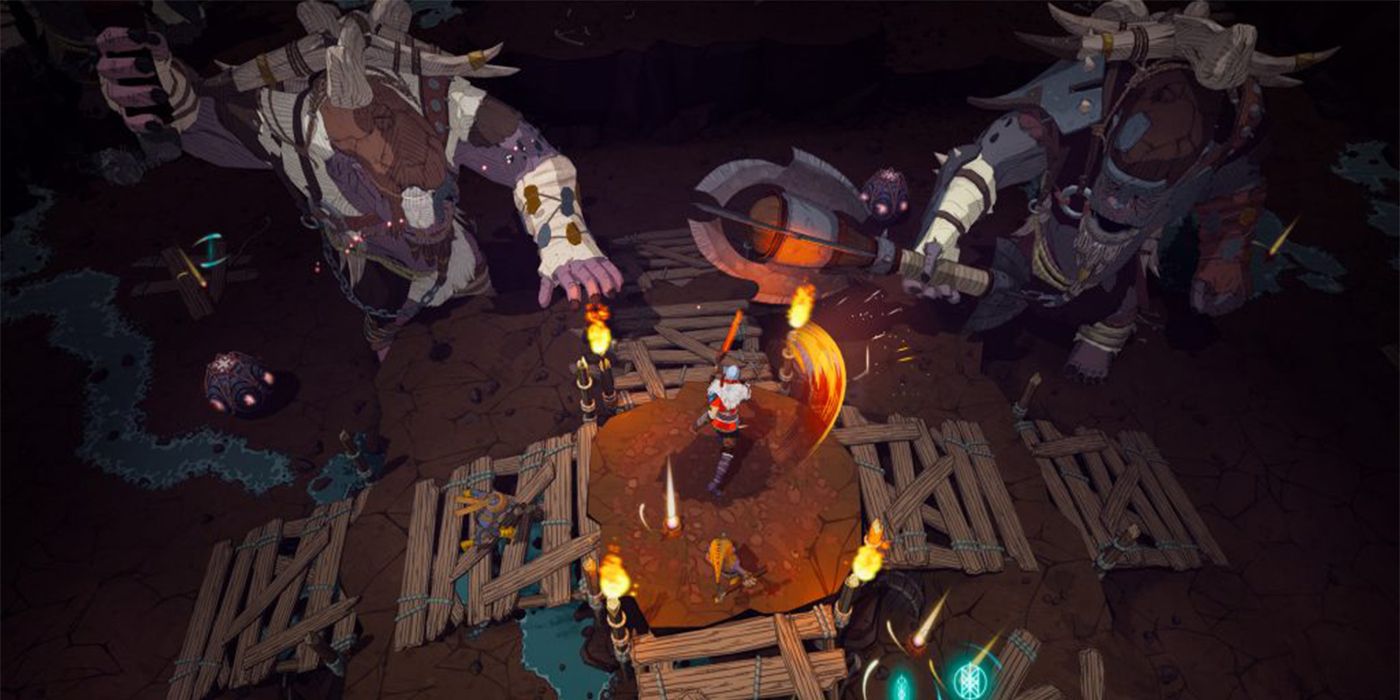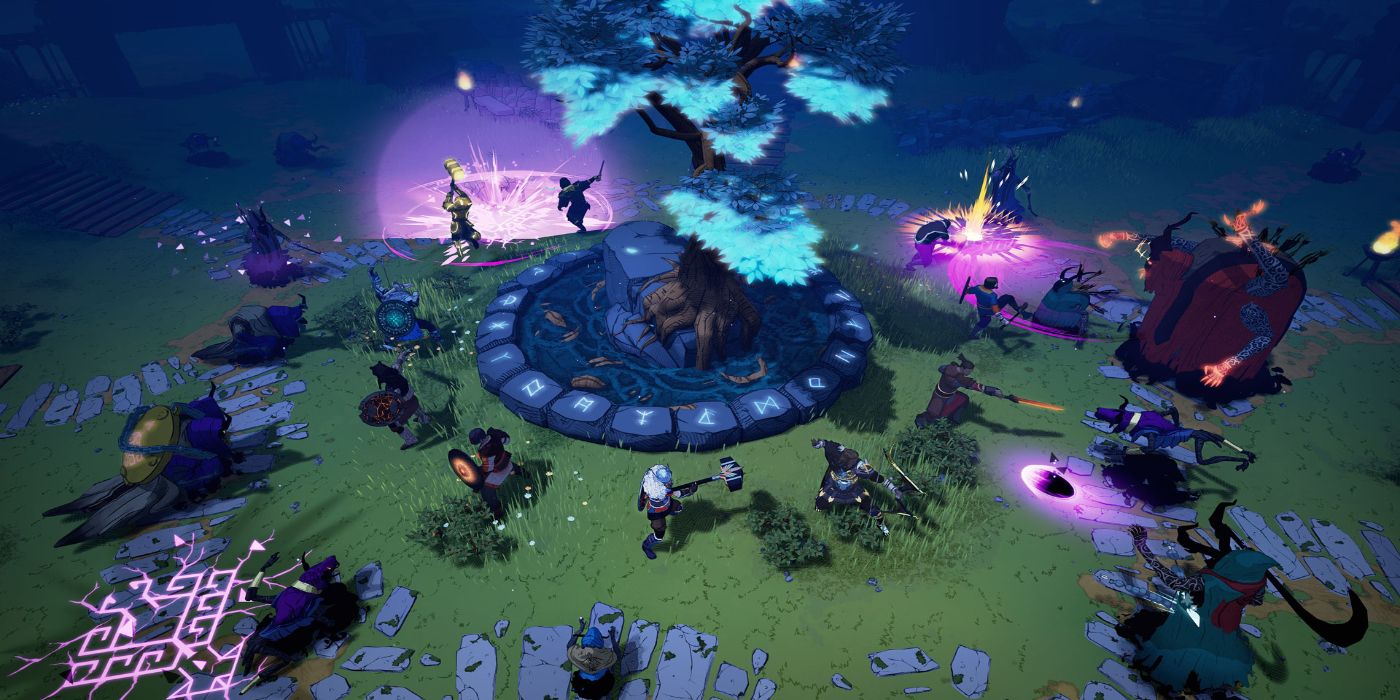
During the beginning of E3 2021, Game Rant was able to get an interview with Norsfell CEO Julian Maroda after the new trailer for Tribes of Midgard had been shown. In that interview, Julian covered the importance of creating a more accessible survival game that also took the best of mechanics before it. Recently, Game Rant played a hands-on preview of a large multiplayer experience in the Saga mode and explored everything from the crafting to defeating the fabled Jötunn that is getting ever closer to the Seed of Yggdrasil. During the playthrough, it was apparent how much Tribes of Midgard relies on the community supporting one another.
After the playthrough, Game Rant was able to sit down with Maroda again to discuss the shown mechanics in greater depth. This time around, Julian discussed the importance of time management and communication between the villagers in Tribes of Midgard in order to defend and thrive inside of this dangerous Norse world. That being said, Julian also touches on the want to create a more lighthearted experience that is meant to promote as much fun as a challenge in the various modes. The difficulty also varies based on how many players are in the match, with a solo and multiplayer experience differing in a meaningful way.
RELATED: Assassin's Creed Valhalla: 10 Famous Real Viking Warriors (Who Aren't In The Game)
Game Rant: What led to the inclusion of the communal War Chest for crafting?
Julian Maroda: It took a long while to implement because we were like “What game does this? What game actually has a chest that everyone can pour in and take from immediately as part of the crafting?” We were kind of worried, like imagine we’re both on a menu, someone crafts something and then it updates on my side and all of a sudden, I don’t have enough materials. In the end, when we implemented it, we weren’t skeptical but it was almost like a prototype. And then we started playing around with it there was no going back.
Actually, it’s the same, we talk about crafting but if you wanna repair a gate or build a watchtower, it also pools from the chest. It’s everything within the vicinity of the village that’s impacted by it. There is also a positive impact in that you want to share your materials, but the other players might use them, so we have some players sometimes just hoard materials because they don’t wanna share. But then they die and lose them so it’s always that kind of battle between the two, in the end, it creates a nice tension.
GR: Why did you feel it was important to add a fast travel system?
JM: Time is of the essence in Tribes of Midgard. It’s really about traveling to places and you’re kind of running around against the clock, especially in the Saga mode. Because you have that endless winter, Fimbulwinter, which starts at a certain stage. We didn’t get there but it starts a bit later in the game. You’re really pressed to go against the clock. Your best thing is really to go as fast as possible everywhere. So we started adding those shrines around the map, making sure that they are all located on all the main roads that the generation creates.
Not only are you running faster on these roads, but you are also discovering points of interest. Even the merchants, the shrines, and the ruins are all located pretty close to roads. That’s on purpose. It was important for us to be able to have a way to go back to the village pretty rapidly and at first, we just had that, and as you saw yesterday, that’s not even enough. Given that the gauge you need to maintain is the health of Yggdrasil, what’s very important is that you keep it alive. So you have to have the ability to return to the village or defend it if it does go south.
We added a second system, you do have a runestone with you that you can activate to teleport back to the village immediately and, of course, that runestone does have a cooldown of one day in-game so you have to play with it carefully. We have one class, the Warden, which is one of the classes that are locked that plays around with that concept. Where you can actually travel back and forth instead of just back, it has a lower cooldown. It’s one of the most advanced classes and it really makes use of that. It goes to show it’s a very important part of Tribes and playing the game without Shrines would be very hard.
GR: Are there any hopes to introduce Tribes of Midgard to additional platforms?
JM: At the moment, we are very excited to release it on PlayStation and PC. I can’t speak about the future, but that’s all I can say for now.
GR: Where does your love of Norse mythology come from, how did it start?
JM: Good question. I’m not actually sure where it starts, but as you can see, even in the company name and logo it’s definitely present. I’m not sure when I was first exposed to it. Through the making of Tribes, I knew quite a bit about it, but I learned so much more by doing more research. I mean, I don’t have to go very far. (Julian lifts up an ornate green book about Norse myths.)
What we wanted to achieve with Tribes was to make Norse mythology more accessible, because again, it’s something that is present in Western cultures quite a bit. There are a lot of funny stories in the Norse mythology, there are some fun stories of even Thor dressing as a bride to recover his hammer and some things with Loki, where it’s not even PG-13, it’s just so rich.
RELATED: Norse Games are Growing a Little Tired, Yet There's So Much Potential for More
GR: How can a single Einherjar experience differ from a large co-op one?
JM: Speaking just for Saga mode, in solo the main difference is that the map is smaller. And because time is of the essence in Tribes, having a smaller map allows you to get around it much faster, explore all of it. We also changed the delay between when the Giants are spawning and when the first one appears so as to give you a bit more time. Those are the major differences in what you can feel directly, gameplay-wise. The rest is so many parameters we play with on balancing. Overall it feels different, which is a great thing. What you experience as a solo player and what you experience with even a handful of players is quite different.
GR: What is your hope in spearheading the “Surthrival” genre?
JM: What’s the saying in English? “Imitation is the sincerest form of flattery.” I would say that would be pretty cool to see if another player comes in and tries to mimic the kind of thing we do because we really believe we’re creating something brand new and we might inspire other studios to do the same. I don’t know if “Surthrival” is ever gonna be a Steam tag, that’d be pretty cool, but if so we’ll have been happy to be the trailblazers of that new genre.

GR: Why is communication so important in Tribes of Midgard?
JM: Because you have a communal objective, which goes back to the very beginning of why we made the game. Instead of surviving on your own and maintaining your own hunger, thirst, and temperature, we summarize most of that into the Seed of Yggdrasil, that’s the thing you have to keep alive as a community. It’s not just you who’s gonna keep it alive, it’s the whole village. So in that sense, because you have a communal objective, you have to have communal ways of communication in-game. It was important for us to give those tools to the players in various forms, so things like Vivox, the fact there is text chat, those are means that make sure people communicate with one another.
It’s deeper than that, there are many other systems where we made conscious decisions to facilitate that kind of informal osmosis communications. So you see a lot of alerts on what’s happening in the world like you see when someone has given souls, you see when someone has died, when someone has upgraded a station, or if the gates get destroyed. You get those notifications all the time. Blowing the rally horn tells people you need them back at the village. It goes as far as things like, if you don’t know which Giant is coming, you have to go and scout it. But as soon as someone has found it, the icon appears on the map that’s the actual icon of the Giant that’s coming. So we tried to add as much communication, you can even see who plays which class on the map, so you can choose which class to compensate for.
GR: With the Tribes of Midgard release date quickly approaching, what does the future look like for Norsfell?
JM: The future is bright, it’s very bright. We’re super excited to deliver this game after almost 4 years of work on it. We’re delivering Season One and there are many more seasons to come, and as mentioned that’s really our vision to create a Viking sandbox. You haven’t heard the last of Tribes of Midgard, you’re gonna hear about it for the months and years to come for sure.
Tribes of Midgard will be available July 27th, 2021 for PC, PlayStation 4, and PlayStation 5.

